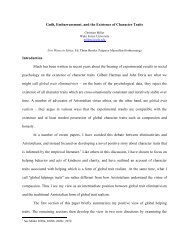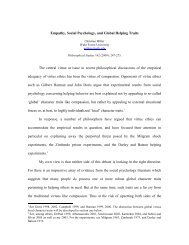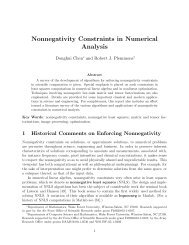The burning questions - Wake Forest University
The burning questions - Wake Forest University
The burning questions - Wake Forest University
Create successful ePaper yourself
Turn your PDF publications into a flip-book with our unique Google optimized e-Paper software.
Chemo<br />
Sense<br />
SPECIAL AACSS ISSUE<br />
What is it that makes an orange tangy, a<br />
glass of beer refreshing and gives<br />
Chicken Tandoori its bite? It’s pain! In<br />
this issue Wayne Silver reviews the<br />
trigeminal or chemesthetic sense,<br />
revealing how the irritation of a special<br />
bundle of nerves plays a major role in the<br />
flavour and aroma of foods.<br />
Also in this issue, Bets<br />
Rasmussen investigates the biggest<br />
nose of all — that of the majestic<br />
elephant. Elephant olfaction is leading to<br />
an understanding of how smell works at<br />
a molecular level. Rasmussen has<br />
shown how male elephant mucus<br />
combines with female pheromones as a<br />
bridging step to reproductive signalling.<br />
<strong>The</strong> female elephant’s urine is lifted by<br />
the tip of the male’s trunk and directed<br />
into the ducts of a part of the nose called<br />
the vomeronasal organ (VNO). <strong>The</strong><br />
elephant VNO tells the male that the<br />
female is about to ovulate. Humans have<br />
a VNO visible only through a microscope,<br />
whereas the elephant’s is the size of your<br />
finger. Does size matter? And if humans<br />
have similar pheromones how do they<br />
reach the human nose? And what<br />
messages do they carry?<br />
As a special feature this<br />
16 page issue includes abstracts from<br />
the most recent meeting of the Australian<br />
Association for ChemoSensory Science.<br />
From the world of business,<br />
Kemal Avunduk, an Australian living and<br />
working in Japan, brings us some advice<br />
on judicious use of the tongue.<br />
Plus, ChemoSense brings you<br />
the latest news and upcoming events in<br />
the chemosensory world.<br />
ISSN 1442-9098<br />
Vol. 2 No.1 November 1999<br />
Chemesthesis:<br />
<strong>The</strong> <strong>burning</strong> <strong>questions</strong><br />
By Wayne Silver, <strong>Wake</strong> <strong>Forest</strong> <strong>University</strong><br />
Animals have evolved a variety of chemoreceptive organs to sense chemicals in<br />
their external environment. Gustation and olfaction (taste and smell), are usually<br />
recognised as the ‘chemical senses’. However, there is another sense that we use to<br />
detect chemical stimuli. This sense was named the ‘common chemical’ sense by G.H.<br />
Parker in 1912 to describe the sensory system responsible for detecting chemical<br />
irritants.<br />
Although Parker noted that the common chemical sense was mediated by free<br />
nerve endings resembling pain receptors, he concluded that “the common chemical<br />
sense is a true sense with an independent set of receptors and a sensation quality<br />
entirely its own”.<br />
Today we know that the free nerve endings do not constitute a separate, independent<br />
sense. Rather, they are part of the general somatic sensory system: a subset of<br />
pain- and temperature-sensitive fibres which can be found throughout the skin and<br />
mucosal membranes of the nose, mouth, respiratory tract, eye, and anal and genital<br />
orifices.<br />
<strong>The</strong> chemesthetic sense<br />
Centre for ChemoSensory Research<br />
<strong>The</strong> <strong>University</strong> of New South Wales<br />
<strong>The</strong>se nerve endings also respond to chemicals, including irritants, and the term<br />
‘chemesthesis’ has recently been used to describe the sensations elicited by their<br />
chemical stimulation. We stimulate our chemesthetic sense every time we eat chilli<br />
peppers, sniff ammonia, or cut onions (see Box, next page). <strong>The</strong>re are many important<br />
reasons for seeking to understand our chemesthetic sense, not the least of which is to<br />
better appreciate its role in flavours and aromas.<br />
In humans, nerve fibres in the trigeminal (Vth cranial) nerve, innervating the mouth,<br />
nose and eyes, best exemplify chemesthesis<br />
(see Figure 1). While free nerve endings<br />
originating from some other cranial nerves also<br />
respond to chemical stimuli, much of the<br />
research on chemesthesis, especially as it<br />
relates to taste and smell, involves trigeminal<br />
chemoreception.<br />
Some nerve fibres in the trigeminal nerve<br />
respond to touch, some to cold, some to heat,<br />
and some to ‘painful’ stimuli. Those fibres that<br />
respond primarily to chemical irritants are<br />
called capsaicin-sensitive polymodal<br />
nociceptors.<br />
cont. pg 2<br />
INSIDE:<br />
Chemesthesis<br />
Business in Japan<br />
Elephant Olfaction<br />
AACSS Abstracts<br />
In the News<br />
1
2<br />
CHEMESTHESIS continued<br />
That is, they are receptors that respond to a variety of<br />
noxious, irritating stimuli (mechanical, thermal, and chemical)<br />
and are especially sensitive to capsaicin (the active, ‘hot’<br />
ingredient in chilli peppers). When capsaicin stimulates these<br />
nociceptors it elicits a <strong>burning</strong> pain sensation.<br />
Recently, a capsaicin receptor (VR1) has been isolated.<br />
<strong>The</strong> receptor is a non-selective cation channel in the nerve<br />
membrane, activated not only by capsaicin, but also by high<br />
temperatures in the noxious range (Caterina et al., 1997).<br />
That <strong>burning</strong> sensation<br />
A variety of sensations are elicited by stimulation of<br />
trigeminal chemoreceptors, including those described as<br />
pungent, tingling, stinging, <strong>burning</strong>, cooling, warming, painful,<br />
and irritating. In addition to providing a sensory experience,<br />
chemical stimulation of trigeminal chemoreceptors activates<br />
protective reflexes, such as increased secretion, decreased<br />
breathing, sweating, and decreased nasal patency. Anyone<br />
who has bitten into a chilli pepper or taken a whiff of ammonia<br />
has experienced some of these reactions.<br />
A curious aspect of chemesthesis is that, although many<br />
chemesthetic substances are initially (and probably innately)<br />
aversive, they eventually become preferred. Examples include<br />
tobacco, chilli pepper, mustard, curry, horseradish, ginger, and<br />
vinegar. Infants, children, and uninitiated adults typically reject<br />
these substances on first exposure. Most adult humans,<br />
however, reverse their natural aversion and develop strong<br />
positive responses to at least one initially unpalatable substance.<br />
Indeed, whole cuisines, such as Mexican and Thai,<br />
are based on some of these chemesthetic stimuli. How the<br />
reversal of the initial aversion occurs is not well understood but<br />
any explanation has to account for the inability to produce<br />
preferences for these compounds in most other animals.<br />
Putting the tingle, fizz and bite into foods<br />
A number of important <strong>questions</strong> remain to be answered<br />
concerning chemesthesis. We do not yet know to what extent<br />
it contributes to our perception of odour, tastes, or flavours.<br />
Could chemesthetic stimulation enhance or diminish perception?<br />
Research is also currently under way to determine<br />
whether different chemesthetic stimuli elicit different sensations.<br />
For example, can people lacking olfactory systems<br />
discriminate between different irritants based on the quality of<br />
those irritants? If the answer to this is yes, it suggests that<br />
different stimuli have specific receptors. This could be an<br />
important finding that would allow the creation of compounds<br />
specifically targeted to bind to specific receptors and elicit<br />
specific sensations. Perhaps some day we may be able to<br />
purchase ‘designer’ hot sauces and seasonings to spice up<br />
our foods in new ways.<br />
All of this is good news for those of us who like food that<br />
bites back.<br />
Caterina, M.J., Schumacher, M.A., Tominaga, M., Rosen, T.A., Levine, J.D.,<br />
Julius, D. (1997). <strong>The</strong> capsaicin receptor: a heat-activated ion<br />
channel in the pain pathway. Nature 389:816-824.<br />
Figure 1 Branches of the chemically sensitive trigeminal nerve<br />
in the regions of the mouth and nose.<br />
Figure 1<br />
‘Pungency’:<br />
<strong>The</strong> Trigeminal Chemosense (Chemesthesis)<br />
<strong>The</strong> sensations arising from the chemesthetic sense are<br />
described as ‘hot’, ‘warm’, ‘pain’, ‘burn’, ‘bite’, ‘sting’, ‘prickle’,<br />
‘itch’, ‘tingle’, ‘fizz’, ‘numbness’, ‘freshness’, ‘chill’, ‘coolness’<br />
and ‘coldness’.<br />
Foods that invoke the chemesthetic sense include:<br />
chilli, pepper, mustard, ginger, onion, garlic, horseradish,<br />
peppermint, cumin, coriander, cinnamon, cloves, spearmint,<br />
carbonated drinks, sherbet, salt, vinegar, fruit powders and food<br />
acids.<br />
Chemical compounds that act on the Trigeminal nerve<br />
endings:<br />
capsaicin (from chilli) piperine (from pepper)<br />
gingerol (from ginger) zingerone (from ginger)<br />
allyl isothiocyanate (from mustard)<br />
cinnamaldehyde (from cinnamon)<br />
cuminaldehyde (from cumin)<br />
2-propenyl/2-phenylethyl isothiocyanate (from horseradish)<br />
carbon dioxide (bubbles in carbonated liquid)<br />
some salts, including sodium chloride<br />
some acids, including acetic and citric acid<br />
alcohol , ammonia, nicotine, menthol<br />
thymol (from thyme)<br />
eucalyptol (from eucalyptus plants)

















